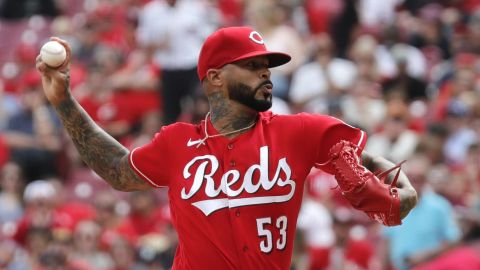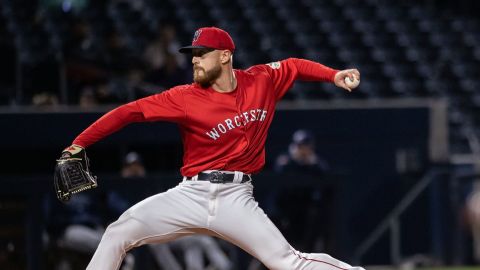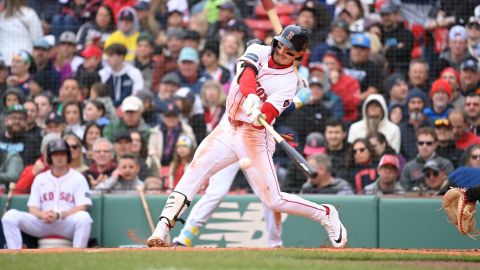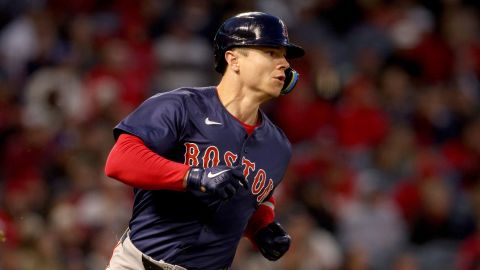The Boston Red Sox are looking toward 2016. We should, too.
There’s a lot to be gained over the next couple of months despite the Red Sox tumbling their way to another last-place finish in the American League East, as Boston can evaluate certain aspects of its roster before entering an incredibly important offseason. Moves need to be made and pieces need to be added, yet conclusions drawn down the stretch could give the Red Sox a better sense of direction.
It’s almost impossible to predict what Boston’s 2016 roster will look like. Some areas are clearer than others, but one should expect general manager Ben Cherington and Co. to look under every rock — as the GM recently put it — in order to field the best team possible. Nothing should be ruled out.
Does that mean a huge trump is in the cards? Maybe. Maybe not. The onus is on the Red Sox to be creative, though, as another last-place finish simply won’t fly in Boston.
Since the Red Sox stood pat at the Major League Baseball non-waiver trade deadline, with the exception of adding reliever Ryan Cook, this seems like a good time to take a stab at projecting next season’s Opening Day roster. It’s a fruitless exercise for many of the reasons mentioned — my pre-2015 roster projection for 2016 featured Cole Hamels and not Rick Porcello, for instance — but it’s a fun one.
Keep in mind as you glance over the following that it’s simply to stimulate discussion as the Red Sox gear up for an interesting winter. Sometimes, one must throw caution to the wind and think outside the box.
The following suggestions merely are that, and nothing more. I’m open to criticism — even pure hatred, if that’s your thing — so don’t hold back. It’s paramount that we watch good baseball next summer.
Lineup
Mookie Betts, CF
Dustin Pedroia, 2B
Xander Bogaerts, SS
David Ortiz, DH
Hanley Ramirez, 1B
Pablo Sandoval, 3B
Rusney Castillo, RF
Chris Young/Brock Holt, LF
Christian Vazquez, C
— Bogaerts and Betts are centerpieces, Pedroia still is considered Boston’s catalyst despite a few injury plagued campaigns and Ortiz’s 2016 option kicked in with his 425th plate appearance of 2015.
— Swihart probably is the Red Sox’s catcher of the future. If so, it’s hard to argue against based on the potential he’s already flashed this season while being thrown into the fire.
Vazquez shouldn’t be forgotten as he continues his rehab from Tommy John surgery, though. And if the Red Sox deal a young catcher to address an area of significant need — read: the rotation — Swihart clearly has much more value, as Vazquez isn’t considered an elite prospect despite his obvious strengths. The question is whether the Red Sox even would entertain the idea of trading Swihart.
For the purposes of this exercise, I went with Vazquez as Boston’s starting catcher next season, although it’s a toss-up based on market developments. It is, however, difficult to imagine the Red Sox starting the season with both Swihart and Vazquez on their major league roster simply because both are at similar stages of their careers — young and developing — and veteran Ryan Hanigan is under contract.
— Three corner spots — first base, third base and left field — need to be addressed.
If Hanley Ramirez (left field) and Pablo Sandoval (third base) stick at their respective positions, it’ll leave the Red Sox without a first baseman. Allen Craig and Travis Shaw are internal options, but neither represents a safe bet — or even a reasonable gamble — unless something major happens down the stretch.
The Red Sox absolutely need to consider trying Ramirez at first base. He’s been a disaster in left field since Day 1 and there’s no way a team with a stated emphasis on improving its defense can expect a significant jump from a 32-year-old who fits the mold of a designated hitter. Perhaps he’ll flop at first base, but it’s the best destination until Ramirez eventually succeeds Ortiz at DH.
Sandoval is an option to move across the diamond, too. He’s been brutal at third base this season. But at least there’s a track record of Sandoval being able to hold his own at his current position. It really comes down to choosing the lesser of two evils, and I’ll take my chances with Panda at the hot corner.
That leaves the Red Sox with a hole in left field. There’s something very intriguing about an outfield comprised of Betts, Castillo and Jackie Bradley Jr., especially for a club looking to enhance its run prevention amid an ongoing struggle to find consistent pitching. All are athletic, all are under team control and all have major upside, though each player’s upside/ceiling is different. It would be difficult to pencil in Bradley as a starting outfielder without significant offensive strides at the major league level, though, and there probably isn’t enough time this season for him to prove himself in that regard — Sunday’s fireworks with the bat notwithstanding.
That said, we’ll stick Castillo in right field — he’s still making adjustments, but his progress is evident — and rely on a platoon in left field. Chris Young, currently of the New York Yankees, is set to become a free agent this offseason and has been mashing left-handers all season. Using him in conjunction with Brock Holt, who still could bounce around, seems plausible. Bradley can hone his craft as a fourth outfielder who receives ample opportunities based on matchups, etc.
All of this, of course, is based on the idea Ramirez and Sandoval will be with the Red Sox next season. It would behoove Cherington to explore all possibilities, but each player’s contract makes life difficult.
Bench
Young/Holt, OF/UT
Jackie Bradley Jr., OF
Travis Shaw, 1B/3B
Ryan Hanigan, C
— Much of this already has been addressed. Shaw secures the final spot because of his ability to play both corner infield positions, though Deven Marrero and Garin Cecchini also should receive long looks as potential bench options. Josh Rutledge is around, too.
Marrero is a slick defender who can shift around the infield. Cecchini can play first base, third base and left field, and he could fill Daniel Nava’s vacated role at some point.
Rotation
Stephen Strasburg, RHP
Clay Buchholz, RHP
Eduardo Rodriguez, LHP
Rick Porcello, RHP
Wade Miley, LHP
— Porcello’s contract seems immovable, so the Red Sox need to bank on a rebound.
— Buchholz is under contract at a reasonable rate and should thrive, provided the Red Sox understand they’re probably not going to receive 30 starts from the right-hander.
— Rodriguez looks legit. He’s someone who might take the next step. He’s already pretty good.
— Miley is a perfectly fine No. 5 starter who can give you (mostly) quality innings.
— Strasburg!? What!? Hear me out.
It’s clear the Red Sox need someone with front-of-the-rotation upside. Acquiring an “ace” needs to be Boston’s top priority this offseason, regardless of who it is the Red Sox ultimately acquire to fill that role.
David Price, Johnny Cueto and Zack Greinke (assuming he opts out of his contract with the Los Angeles Dodgers) all are interesting free-agent options with proven track records. I wouldn’t blame the Red Sox for going down that route — Price would be my top choice based on age, makeup, injury risk and success in the American League — but there’s no denying Boston’s hesitance to splurge on pitchers entering their 30s. The trade market thus seems like a worthwhile, if not likely, avenue.
Carlos Carrasco of the Cleveland Indians and Tyson Ross of the San Diego Padres are logical trade targets. (The most recent mailbag addressed the topic.) But the Red Sox should think even bigger — Ross and Craig Kimbrel would be an intriguing package, though I have concerns about Ross’ ability to front a rotation — and Strasburg has shown an ability to be an elite starter. He’s a legitimate ace when all’s right.
Why would the Washington Nationals trade Strasburg, especially with Jordan Zimmermann and Doug Fister set to hit free agency after this season? Well, in addition to there being rumblings last offseason that the Nationals might consider dealing Strasburg, there’s Bryce Harper’s future to worry about.
Harper isn’t a free agent until after the 2018 season, but it’s reasonable to think — based on his age and skill — he’ll eventually sign the richest contract in the history of baseball. Is there really room in Washington’s budget for that plus whatever Strasburg is going to command on the open market after the 2016 season, especially with Max Scherzer’s contract heavily backloaded? (Scherzer is set to earn $15 million annually through 2018 and then $35 million annually from 2019 through 2021.)
The Nats might want to at least entertain the idea of trading Strasburg rather than letting him walk in free agency, as Tanner Roark, Joe Ross, A.J. Cole and Lucas Giolito all are 2016 starting options beyond Scherzer and Gio Gonzalez. Boston certainly has the pieces to construct a competitive offer.
Why should the Red Sox consider it? Well, beyond Strasburg being a top-flight talent, he’s still just 27. His post-2016 free agency poses an interesting dilemma, but if the Red Sox plan to shell out big bucks for a starter, they might feel compelled to do so for someone of Strasburg’s age and caliber, as opposed to overpaying for either Price or Cueto, both of whom will be 30 next season.
(The Porcello extension — rooted in similar logic — hasn’t worked out, but I’m not necessarily suggesting the Red Sox lock up Strasburg immediately after acquiring him. Also, Porcello never flashed the type of potential Strasburg has.)
Is there risk? Sure. Strasburg already has had Tommy John surgery and he’s proven ineffective at times this season. Plus, the Red Sox could just wait until he hits free agency and reconsider then, rather than relinquishing potential impact talent now.
But the Red Sox desperately need a No. 1 starter for 2016. And unless someone like Chris Sale or Sonny Gray — two dream targets who are cost-controlled — walks through that door, Boston should consider Strasburg for his extremely high ceiling, provided Washington would entertain the idea.
Bullpen
Drew Storen, RHP
Koji Uehara, RHP
Junichi Tazawa, RHP
Joe Kelly, RHP
Steven Wright, RHP
Charlie Furbush, LHP
Mike Dunn, LHP
— Here’s where things become even more interesting.
The Red Sox badly need bullpen reinforcements. If they heed my advice and pursue Strasburg, then why not swing for the fences and inquire about Storen, too?
Storen, like Strasburg, is a 27-year-old who’s slated to hit free agency after the 2016 season. The whole Jonathan Papelbon situation didn’t sit well with the replaced closer, so would it really shock anyone if the sides had a falling out this winter, leading to a less-than-amicable breakup?
The Red Sox obviously have an excellent closer in Koji Uehara. But he’ll also be 41. If part of the deal with acquiring Storen is that he’ll assume the ninth-inning duties with Uehara pitching the eighth (and, in turn, Tazawa pitching the seventh), then so be it. Sounds like a good back end, if you ask me.
This all falls under the “let’s get a little crazy” umbrella, which is the one the Red Sox should be standing under right now, all things considered.
— The Red Sox should have converted Kelly back into a reliever yesterday.
— Wright will be out of minor league options, but he’s someone you want to keep in your organization. Boston could do worse than sticking him in the bullpen with the understanding he’ll also be the club’s No. 6 starter.
— Remember when there was a rumor the Red Sox explored a trade for Furbush of the Seattle Mariners? Let’s revisit that whole thing. The Mariners need to make some changes, right?
Left-handed hitters (as of Saturday) had a .484 OPS against Furbush since the beginning of 2014. That’s the sixth-best mark among all left-handed relievers with at least 50 appearances in that span — right behind Aroldis Chapman (.462).
— Mike Dunn is another left-handed reliever who’s tough on lefties. He’s under contract only for 2016, so perhaps the Miami Marlins will be inclined to move him in an effort to dump salary.
— Jerry Blevins, a free agent-to-be, is another interesting candidate given his dominance against left-handed hitters, but he re-fractured his forearm this week and will miss the remainder of 2015. He’s a good buy-low option if someone like Furbush or Dunn can’t be had in a trade.
— -Matt Barnes is a name to consider, but he hasn’t shown much in a relief role despite an arsenal that seemingly fits the job description. The Red Sox actually might be better off grooming him as a starter at this point, especially since the organization will have a shortage of high-level starting pitching prospects as Rodriguez, Henry Owens and Brian Johnson graduate to the next level.
— Pat Light is another power arm to monitor for 2016. He just needs more seasoning at Pawtucket.
Thumbnail photo via Adam Hunger/USA TODAY Sports Images




